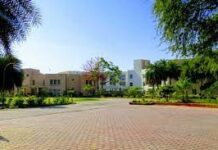 Eight hundred years after the destruction of Nalanda, former President of India Dr. A.P.J. Abdul Kalam, while addressing the Bihar State Legislative Assembly, in March 2006 mooted the idea of reviving the university.
Eight hundred years after the destruction of Nalanda, former President of India Dr. A.P.J. Abdul Kalam, while addressing the Bihar State Legislative Assembly, in March 2006 mooted the idea of reviving the university.
Almost simultaneously, a proposal termed the “Nalanda Proposal” was forwarded to Government of India by Singapore. This proposal sought the re-establishment of a University like Nalanda which would once again be the focal point of Asia.
The State Government of Bihar quickly adopted the visionary idea and consulted the Government of India on the way ahead. It also began its search for a suitable location for the new Nalanda University. It identified and acquired 450 acres of land for the University in Rajgir¸ Bihar.
The establishment of this University was thus marked by a high degree of co-operation between the State of Bihar and the Government of India.
Since the hallmark of the ancient Nalanda was its internationalism, the Government of India decided to share this proposal with the leaders of the East Asia Summit (‘EAS’). The proposal was first shared with the sixteen members States of the EAS at the Cebu Summit in Philippines in January 2007. The Member States welcomed the regional initiative for the revival of Nalanda University. At the fourth Summit held in October 2009, at Hua Hin, Thailand, members supported the establishment of the Nalanda University and encouraged regional networking and collaboration between the University and existing centres of excellence in East Asia.
History of old Nalanda
The establishment of the ancient Nalanda as an undisputed seat of learning was a natural consequence of the time and place in which it was situated. Ancient Magadha was characterized by an intellectual ferment unlike any known to mankind. Nalanda University was able to meld multiple discourses and to embrace knowledge in its entirety to become uniquely attractive for all seekers of pure knowledge.
Historical sources indicate that the University had a long and illustrious life which lasted almost continually for 800 years from the fifth to the twelfth century CE. It was a completely residential university believed to have 2,000 teachers and 10,000 students. The Nalanda ruins reveal through their architectural components the holistic nature of knowledge that was sought and imparted at this University. It suggests a seamless co-existence between nature and man and between living and learning.
The profound knowledge of the Nalanda teachers attracted scholars from places as distant as China, Korea, Japan, Tibet, Mongolia, Turkey, Sri Lanka and South East Asia. These scholars have left records about the ambience, architecture and learning of this unique university. The most detailed accounts have come from Chinese scholars and the best known of these is Xuan Zang who carried back many hundred scriptures which were later translated into Chinese. Close to the end of the twelfth century Nalanda was destroyed by invaders.
The period from which Nalanda ceased to exist was a time that the great universities of the western world came into being, marking the shift in knowledge production and dissemination from the East to the West. Only Al Azhar in Cairo (972 CE), Bologna in Italy (1088 CE) and Oxford in the United Kingdom (1167 CE ) had been founded before the destruction of Nalanda.
The ancient Nalanda was a centre of learningfrom the fifth century CE to twelfth century CE.







